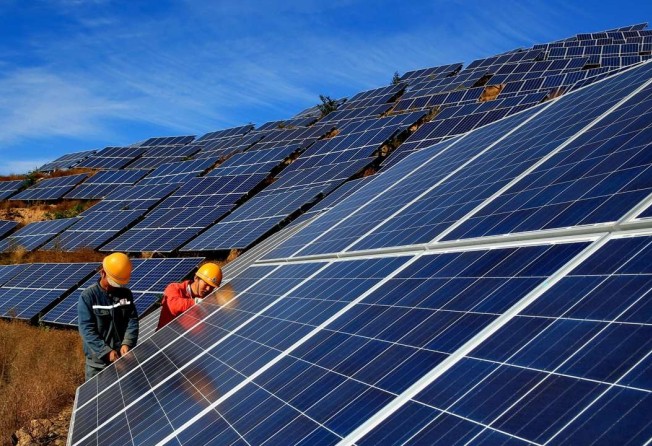United Photovoltaics bucks slowdown in solar farms with expansion plans

United Photovoltaics, a solar farm developer partly owned by financial services-to-property conglomerate China Merchants Group, aims to raise its generating capacity by 46 per cent this year, according to its chief executive.
This is despite an expected slow down in the industry’s growth due to constraints including power grid bottlenecks and unpaid government subsidies that eroded returns and stymied the ability of developers to raise more financing.
Grid bottlenecks resulted in 10 per cent of the solar power generated on a national level not being dispatched to the power grids last year, known as the curtailment rate. The problem is most acute in sunlight-rich but sparsely populated northern China, where the ratio averaged 20 per cent.
“Our generation curtailment rate due to grid capacity shortages was less than 10 per cent last year thanks to careful site selection and consideration of local demand,” chairman and chief executive Alan Li Yuan told the South China Morning Post in an interview at the sidelines of the SNEC solar power conference in Shanghai.
Beijing aims to reduce the national solar power output curtailment rate to 3 per cent by 2020, upon completion of various high voltage, high capacity power distribution lines to send surplus electricity from the north to central and coastal regions.
Analysts at industry research provider IHS forecast developers will install 26,000 megawatt (MW) of new solar farm capacity this year in China, falling to an average of 20,000 MW in the three years to 2020, down from a record 34,500 MW last year, citing the constraints.
The nation’s renewable energy subsidies owed to developers amounted to 60 billion yuan (US$8.7 billion) last year, which could increase further unless power prices are raised or subsidies slashed. The average waiting time for disbursement is two years.
Beijing has already substantially increased the use of open bidding on power prices to allocate new project permits, instead of relying on the old model of guaranteeing subsidised prices to encourage project construction.
United is 14.6 per cent owned by China Merchants New Energy, 6.8 per cent by Li and 5.3 per cent by parties acting in concert with them.
Japanese financial services group Orix – a major investor in renewable energy projects – owns a 14.4 per cent stake after completing a shares subscription last month at 58.1 cents each.
United shares closed 11 per cent higher on Wednesday at HK$1.2. They have surged 64 per cent since the start of the year, compared to a 12 per cent gain in the Hang Seng Index.
United has invested in 1,291 MW of solar farm capacity in China, with the majority of these projects in the north. The total capacity includes projects in which it has controlling stakes or minority stakes, as well as joint ventures.
United made a maiden overseas foray by acquiring 82.4 MW of solar plants in Britain in January.
It has in the pipeline some 700 MW of domestic projects with preliminary approval, mostly in northern and eastern regions of the country, Li said. He added that for this year, the company aims to complete installation of 300 MW in China, and finish another 300 MW overseas.
Supported by a United Nations Development Programme, United plans to build 150 solar farms of 50 MW capacity each over the next decade in nations covered by Beijing’s Belt and Road initiative, a trade development strategy aimed at encouraging closer economic partnerships.
These so-called “panda solar farms” are designed to look like the Chinese panda when viewed from high above.
Asked how they will be financed, Li said as well as tapping low-cost funding from the Asia Development Bank, many potential investors have expressed interest in supporting the initiative to help combat climate change.
He said the firm is aiming for a project return – before accounting for debt leverage – of 8 per cent on domestic projects.

United posted a pre-tax profit of 383 million yuan last year. Excluding non-operating accounting gains arising from acquisitions, financial assets and liabilities, it had an underlying loss of 509 million yuan, compared to a loss of 359 million yuan in 2015 on the same basis.
The wider loss was due to higher depreciation and finance costs as its net debt-to-shareholders’ equity ratio surged to 395 per cent at the end of last year from 258 per cent a year earlier.
To help finance expansion, the firm late last month raised HK$224 million by selling shares equivalent to a 3.6 per cent stake at HK$0.83 each to distressed debt manager China Huarong Asset Management.
Besides owning shares in United, Huarong also holds HK$100 million of bonds convertible to shares at HK$1.23 each maturing next year, and HK$50 million of bonds convertible to shares at 61 cents each and due for repayment in 2019.
Prior to that, United had raised HK$1.7 billion from shares and convertible bond issuances in the preceding 12 months.
The company will be renamed Panda Green Energy next month.